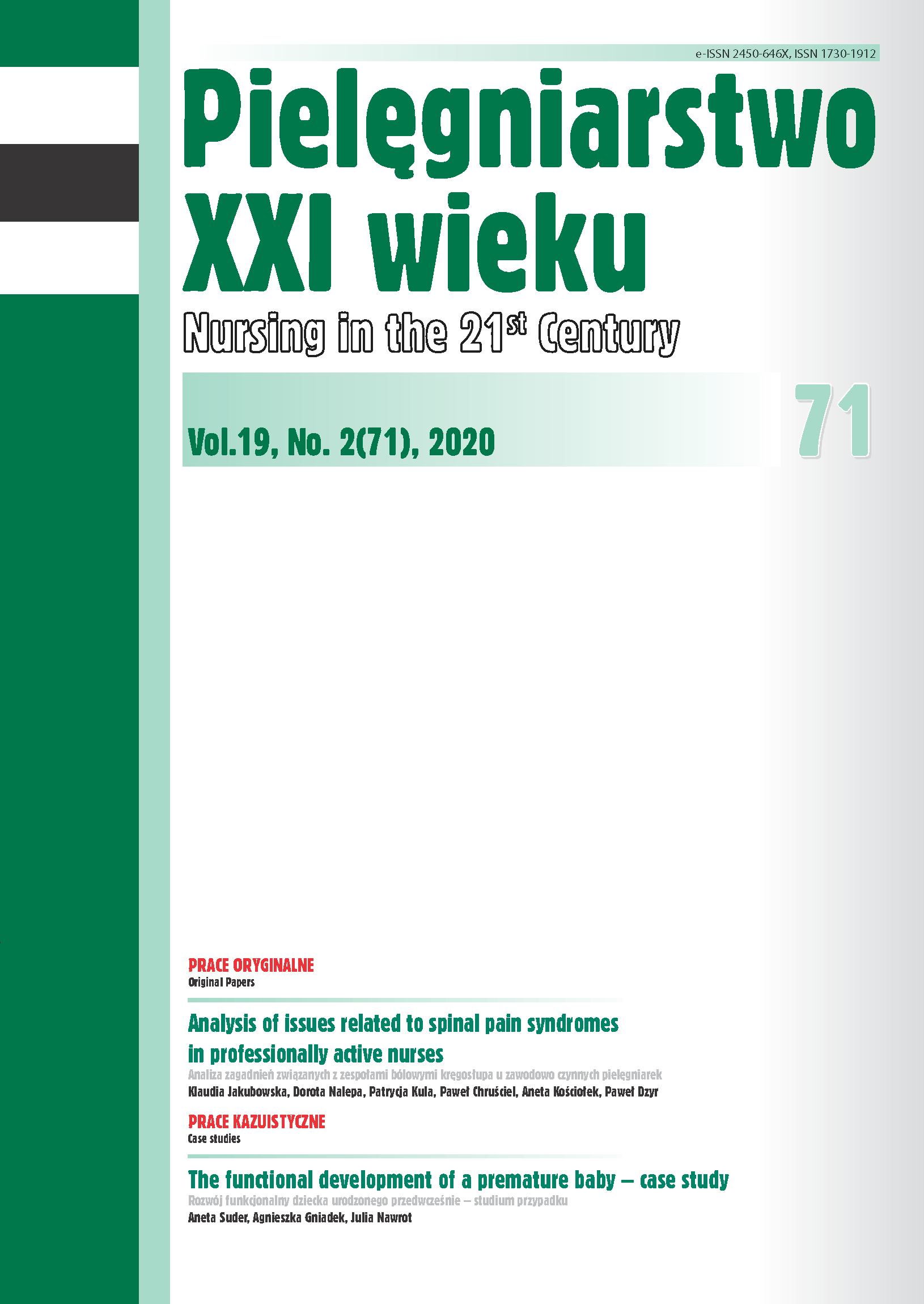Mobile applications in women’s health education in obstetric and gynecological care
DOI:
https://doi.org/10.2478/pielxxiw-2020-0004Keywords:
mobile applications, health education, women, obstetric and gynecological careAbstract
MOBILE APPLICATIONS IN WOMEN’S HEALTH EDUCATION IN OBSTETRIC AND GYNECOLOGICAL CARE
Introduction. The dynamic development of new technologies and the dissemination of mobile applications in everyday life create opportunities for using the new form for activities within the framework of women’s health education.
Aim. The work aims to review mobile applications that can be used in women’s health education in obstetrics and gynecology, and to determine their range of functions facilitating independent control of women’s health.
Material and method. The research of mobile applications was limited to the ones available for Android and iOS (iPhone). The source of all information are the websites of the software producers. The criteria for including the application in the analysis were: availability on the website play.google.com and usefulness in obstetric-gynecological care of women. As many as 27 applications with the highest number of downloads became the subject matter of the analysis.
Results. Due to the substantive scope of women’s health education, mobile applications were classified into three groups: 1) helpful in controlling the menstrual cycle, 2) helpful in monitoring pregnancy, 3) used in the prevention of diseases in gynecological-obstetric care. Out of all the applications available, 10 were classified to the first and second group each, and 7 to the third one.
Conclusions. Mobile health applications are a promising strategy for health education as a tool for monitoring, improving self-control, and raising awareness in the care of women.
References
1. JerpiL. Mobile Phones and Society – How Being Constantly Connected Impacts Our Lives. The Mobile. 2013. Issue 29: Available at: http://source.southuniversity. edu/mobile-phones-and-society-how-being-constantly-connected-impacts-our-lives-137313.aspx (accessed 10. 10.2019)
2. Santoro E, Castelnuovo G, Mauri G, Sicurello F. Social Media and Mobile Applications in Chronic Disease Prevention and Management. Front Psychol.2015; 6 :567. doi: 10.3389/fpsyg.2015.00567.eCollection 2015.
3. Research2Guidance. mHealth App Developer Economics 2016. The current status and trends of the mHealth app market. 2016. Available at: https://research2guidance. com/r2g/r2g-mHealth-App-Developer-Economics-2016.pdf (accessed 18 August 2019).
4. Research2Guidance. mHealth App Economics 2017/2018: Current Status and Future Trends in Mobile Health. 2017. Available at: https://research2guidance.com/wp-content/uploads/2017/11/R2G-mHealth-Developer-Economics-2017-Status-And- Trends.pdf (accessed 18 August 2019).
5. www.itgenerator.pl. 2019. Aplikacje mobilne w branży medycznej. https://www. itgenerator.pl/wp-content/uploads/2019/02/ITgenerator_branza_medyczna.pdf. (accessed 20 August 2019).
6. Bujanowska-Fedak M, Tomczak M, Pokorna-Kałwak D. Zastosowanie nowoczesnych technologii mobilnych w opiece zdrowotnej wyzwaniem dla XXI wieku. PulsUczeni. 2016; (10) 2: 37-43.
7. Aguilera A, Muench F. There’s an app for that: information technology applications for cognitive behavioral practitioners. BehavTher. 2012; 35(4):65–73.
8. Stančič Z. European Commission. The myhealthappsdirectory 2015-2016. Featuring health apps that focus on care in the community, disability, health, and wellness – a review by patient groups and empowered consumer. 2016. PatientView,PDF. http://www.patient-view.com/uploads/6/5/7/9/6579846/_the_myhealthapps_ directory_2015-2016.pdf. (accessed 12 October 2019).
9. Arak P, Bobiński A, Wójcik A. Rynek urządzeń i aplikacji mobilnych w Polsce, w: Chyckowska A. (red.), Bez kabli. Mobilny Internet motorem zmian społecznych i ekonomicznych, Polityka Insight, Warszawa; 2015.
10. World Health Organization. mHealth: new horizons for health through mobile technologies. Global Observatory for eHealth series. 2011; vol 3.Available at: https:// www.who.int/goe/publications/goe_mhealth_web.pdf. (accessed 12 August 2019).
11. Kraschnewski JL, Chuang CH, Poole ES, et al. Paging, ‘‘Dr. Google’’: does technology fill the gap created by the prenatal care visit structure? Qualitative focus group study with pregnant women. J Med Internet Res. 2014; 16(6):e147.
12. Bert F, Gualano MR, Brusaferro S, et al. Pregnancy e-health: a multicenter Italian crosssectional study on internet use and decision-making among pregnant women. J Epidemiol Commun Health. 2013; 67(12):1013–1018
13. Lima-Pereira P, Bermu´dez-Tamayo C, Jasienska G. Use of the Internet as a source of health information amongst participants of antenatal classes. 2012; 21(3-4):322- 330
14. Wallwiener S, Muller M, Doster A, et al. Pregnancy eHealth and mHealth: user proportions and characteristics of pregnant women using Web-based information sources – a cross-sectional study. Arch GynecolObste. 2016; 294: 937–944 DOI 10.1007/s00404-016-4093-y
15. Gao L, Larsson M, Luo S. Internet use by Chinese women seeking pregnancy-related information. Midwifery. 2013; 29(7):730–735.
16. de Santis M, de Luca C, Quattrocchi T, et al. Use of the internet by women seeking information about potentially teratogenic agents. Eur J ObstetGynecolReprod Biol. 2010; 151(2): 154–157.
17. Rezniczek GA, Ku¨ppers L, Heuer H, et al. Quality of websites of obstetrics and gynecology departments: a cross-sectional study. BMC Pregnancy Childbirth. 2015; 15(1):103-14. DOI 10.1186/s12884-015-0537-9
18. Bert F, Passi S, Scaioli G, et al. There comes a baby! What should I do? Smartphones’ pregnancy-related applications: a web-based overview. Health Inform J. 2016; 22(3):608-17. DOI: 10.1177/1460458215574120.
Downloads
Published
Issue
Section
License
Copyright (c) 2020 Authors

This work is licensed under a Creative Commons Attribution-NonCommercial-NoDerivatives 3.0 Unported License.




